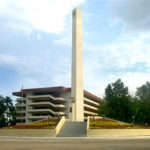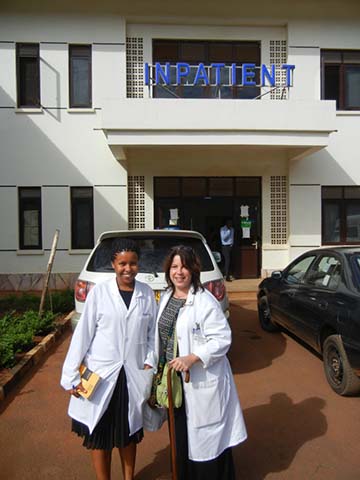EiABC offers undergraduate and postgraduate courses as indicated below
Bachelor Programs at EiABC
Context and Objectives
Ethiopia is experiencing a fast population growth, urbanization and industrial development. EiABC is striving to harmonize the rapid urbanization and industrialization with a balanced and sustainable socio-economic and eco-friendly development with a clear focus on design capacities. EiABC was founded in 2010 as a response to the demands of Ethiopia and its young generation.
The Bachelor Programs enable and prepare students to serve the national labor market or to deepen their studies in domestic and international Master Programs.
Bachelor Programs at EiABC:
- Architecture
- Construction Technology and Management
- Urban and Regional Planning
Bachelor Program in Architecture
Context, Objectives, and Purposes
Architecture is one of the key professions involved in shaping the built environment and urban as well as rural spaces. Architectural education that prepares architects for a professional life should therefore, be seen, at least in the following contexts and the specific objectives pertaining to them:
- Social, cultural, ethical and political context
- Professional, technological, industrial context
- Economical as well as ecological context
- Academic context including science and technology
- International context
There are a number of new contexts such as the increasing internationalization of the building industry, the building professions, and architectural practice itself, the dominant use of the computer and the Internet, etc. which have to be considered in order to produce competent, creative, critically minded and ethical professional designers/builders; and to produce professionals who are intellectually mature, ecologically sensitive and socially as well as ethical responsible.
As there is no fundamental conflict between these two purposes, schools, programs and courses should aim to achieve both of them through different means and vehicles – obviously varying in different geographical and social contexts. As a corollary to the first purpose mentioned, architectural education should also aspire to improve the quality of architectural output in general and architectural practice in particular. In addition to educating well-equipped graduates, this should be achieved by research (i.e. constantly expanding architectural knowledge), by setting good examples, by publishing and by fostering contacts with practices. As a corollary to the second purpose mentioned, architectural education should contribute to the social, economic, ecological and cultural development of society – both nationally and globally.
Space is by its very nature social, and society is spatial. Architecture therefore exists to serve society primarily by designing and planning its spatial infrastructure.Young architects should be encouraged to assume responsibilities as professionals within society. The basic goal of education is to develop the architect as a “generalist” able to design built form often involving potential contradictions between different requirements, and giving form to society‘s and the individual‘s environmental needs. The architect, by virtue of the education received, is the privileged interlocutor of the various elements of society and the state from local authorities and decision-makers to promoters, contractors, users and the public.
Therefore, architectural students should be made critically aware of the political and financial motivations behind the clients‘ brief and building regulations in order to foster an ethical framework for decision making within the built as well as natural environment. Architects can be considered as intellectual services providers whose education enables them to synthesize controversial issues, and contradictory forces. Architects and architecture students must have a responsible professional spirit and a comprehension of environmental ethics. They should work for the benefit of society as a whole, and try to carry out strategies that contribute to the overall quality of human settlements. Architecture should be considered as a service, accessible to the whole community. It could act as a mediator of social tensions and should be considered as a resource, one of the instruments, which contribute to the balance of society.It is essential to restore the cohesion between architectural production and the development of society in the context of cities. The management of public fabric and its change and development is of particular importance, so that planning policies should also be consistent with the cultural evolution of the population.Architecture, the quality of buildings, the way they relate to their surroundings, the respect for the natural and built environment as well as collective and individual cultural heritage are matters of public concern.
Architects have some significant responsibility for the health, safety, welfare and cultural interests of the public and for the sustainability of the built and natural environment. This responsibility should be clearly stated in legislation, defining the architect‘s professional responsibility, and should be acknowledged in public education efforts, by using the media, national press, radio and television to achieve a more serious understanding by the public. Conversely, it is important that society is made aware of the various areas of knowledge, skills and competence that the architectural profession could deliver, and for which, architectural education is expected to prepare them.
Furthermore, the architect‘s education should enable effective intervention in the numerous fields where construction may not be the sole objective.
The Profession
Architecture is an interdisciplinary field that comprises several major components: humanities, social and physical sciences, technology and the creative arts.Since architecture is created in a field of tension between reason, emotion and intuition, architectural education should be regarded as the manifestation of the ability to conceptualize, co-ordinate and execute the idea of building rooted in human tradition. The future of architecture also depends on an understanding and assimilation of the achievements of other disciplines and professions. Although, like other branches of professional education, it is primarily assigned the task of educating future architects, architectural education is, generally, part of the university system and must adjust to and benefit from the traditions of the university, such as doing research and seeing the professional practice within the context of society and science.
Objectives
In view of these complex expectations, the UIA/UNESCO Charter formulated the specific areas of competencies for architectural education as the acquisition of the following, which are also shared by EiABC
- An ability to create architectural designs that satisfy both aesthetic and technical requirements
- An adequate knowledge of the history and theories of architecture and the related arts, technologies and human sciences.
- A knowledge of the fine arts as an influence on the quality of architectural design.
- An adequate knowledge of urban design, planning and the skills involved in the planning process.
- An understanding of the relationship between people and buildings, and between buildings and their environment, and of the need to relate buildings and the spaces between them to human needs and scale.
- An understanding of the profession of architecture and the role of the architect in society in particular in preparing briefs that take account of social factors.
- An understanding of the methods of investigation and preparation of the brief for a design project.
- An understanding of the structural design, constructional and engineering problems associated with building design.
- An adequate knowledge of physical problems and technologies and of the function of buildings so as to provide them with internal conditions of comfort and protection against the climate.
- The design skills necessary to meet building users’ requirements within the constraints imposed by cost factors and building regulations.
- An adequate knowledge of the industries, organizations, regulations and procedures involved in translating design concepts into buildings and integrating plans into overall planning.
Facts and Figures:
Length of Study Program: 5.5 Years
Degree: B.Sc. in Architecture
Admission: Entrance Examination
Mandatory Internship: 1 Semester
Current Number of Enrolments: ~ 650
Bachelor Program in Construction Technology and Management
Context, Objectives, and Purposes
A construction project in present times is becoming a complex and risk-laden venture. It involves the expenditure of a large sum of capital as well as the application of technologies of which many are aware, some are conversant, but few are expert. Construction management evolved from construction site management as a professional practice distinct from design in response to these increasing complexities in the construction industry. This development was observed in the early 1960’s in the USA and in the 1980’s in Europe. Highly sophisticated construction systems led to the specialization of both design and construction professionals. Additionally, increasing regulatory mandates, litigation and other risks created a need for a new professional to be an advocate for the owner and bridge the gap between the owner, the designers and the contractor in order to efficiently manage the construction process.
Construction management began as a further specialization of other professions such as architecture and civil engineering, but presently, with the increasing complexity and versatility of construction projects, it has become useful to begin education in construction management at an earlier stage.
One of the transformations in the construction process has been the introduction of better methods of procurement that could be considered as a remedy for the problems of the old Design-bid-build method. This method has been criticized for its fragmented, bureaucratic and adversarial nature. New approaches such as Design-Build (Turn Key), Build-Operate-Transfer (BOT), Finance-Build-Operate-Transfer (FBOT), have been introduced to streamline the construction process and make it more efficient by avoiding bureaucratic and corruptive involvements. However such complex process has necessitated a separate body to manage the whole process from the project inception to completion by advocating the interest of the client.
The Profession
Construction Management in the Ethiopian context is a new profession. Up till recent years, there has been no professional training in construction management in Ethiopia. Thus the management of construction sites has been covered by different generalist professionals such as civil engineers, architects, advanced diploma graduates of building engineering, site foramen etc. Though there is a significant increase both in volume and complexity of work seen in the construction sector in Ethiopia, several studies in the present state of the sector show that more than 80% of the constructions are delayed, run over budget and/or are marred with claims and continuous and bitter disputes. Further more, the industry is still slow as it largely relays upon labor intensive on site activities, which lack plant manufactured and site assembled construction. The deteriorating quality of construction works is also clearly apparent. As a result international construction companies who possess extensive experience in managing complex constructions are taking over most major construction in the country leaving our local contractors out of the competition. As a result of this the country demands transformation in the construction sector. Such transformations require considerable equipment and plant management specialty. Thus construction management professionals in substantial numbers are highly necessary. The construction technology and management B.Sc. program at EiABC is primarily targeted at addressing this national need.
Objectives
The B.Sc. degree program in Construction Technology and Management has the following specific objectives:
- Through the development of practice oriented education and research, to produce well-qualified professionals in the fields of construction technology and management.
- Promote a strong sense of ethics and professionalism in the construction sector
- Conduct research in the field.
- Provide former graduates in related fields who are involved in the construction industry a chance to develop their skill and competences.
Facts and Figures:
Length of Study Program: 5 Years
Degree: B.Sc. in Construction Technology and Management
Mandatory Internship: 1 Semester
Current number of enrolments: ~ 850
Bachelor Program in Urban and Regional Planning
Context, Objectives, and Purposes
Problems of population growth, ecological threats in agriculture, education, healthcare, urban infrastructure and housing, etc. are the most important challenges of policy makers, development professionals and planners in Ethiopia. Moreover, the number and complexity of urban centers in the country is increasing very fast. Ethiopia is one of the countries in the continent that is urbanizing at a rapid speed.
The basic professional principle of urban and regional planning is Sustainability: sustainability with regard to its three integral parts, which are society, ecology and economy. According to the report of the Brundt land commission (1987) “Sustainable development is development that meets the needs of the present generation without compromising the ability of future generation to meet their own needs”
Within this general framework, the specific principles are:
Concern for the environment: The natural and the built environment are the realms of planners’ operation. Conservation of habitats, scenic locations, agricultural fields, water bodies, and so on is beneficial to human development in a variety of ways. The upkeep of the natural environment is basic to human development as resource base, inspiration, and morality. The culture of societies includes their built and natural settings. Hence, town and regional planners have to consider the upkeep of the environment as a basic concern.
Social justice in resource use: Planning is about optimal use of resources; however, there is also a social dimension to resource distribution. Resources and values can be created through planning. The values created through planning have to be appropriately apportioned to social members. When to develop, where to develop and who should utilize the results of development are central issues in planning.
Concern for public safety: Town and regional plans guide where development should be; where there is advance planning activities and people follow plans. Therefore, planners have to be knowledgeable and careful in the choice of development sites so as not to endanger public safety and all other natural and man-initiated hazards on property and human life
Concern for cultural heritage: The future generation has the same right to enjoy the benefits of cultural heritage as today’s generation. With this in mind, one of the concerns of the profession is to guarantee the fulfillment of this objective.
The Profession
Urban and regional planners have to work individually, in teams, small and large groups. The four main competences of urban and regional planners are:
professional competence, methodological competence, social competence, and personal competence.
However, these four competences can be translated into the following skills:
- Analytical skills for identifying and understanding of problems
- Creative problems solving skills
- Practical design skills
- Rhetorical skills in written and oral communication
- Negotiating, facilitating and networking skills
- Moderating skills for multi-professional working environments
- Methodological skills and use of statistical data and sources of visual, verbal, bibliographical information
- Information sourcing and literacy
- Skills in work preparation,\ and presenting results
- Skills in self – learning
- Awareness of opinions and values of others
- Ability to exercise initiative, original thought and independence, within a system of personal values
Objectives:
All professions had to adhere to a proper code of conduct imposed by the profession and the public at large. The code of conduct normally emanates from the principles of the profession. The following main points constitute ethical objectives of the professions:
- Faithfulness to the public: Town and regional planner has to uphold the highest moral standard in the practice of his/her profession as advisor and policy initiator to public bodies. The interest of the public or public cause shall outweigh over that of individuals.
- Knowledge of the profession: Ill-advising, whether from ignorance or malicious intent, both affect the public and clients. The town and regional planner has to update himself/herself so that the advice one provides is grounded in appropriate knowledge.
- Obligation to the client: Town and regional planners have the obligation towards their client to provide services in a professional manner. They have to act as unbiased faithful advisors to their clients.
Facts and Figures:
Length of Study Program: 5 Years
Degree: B.Sc. in Urban and Regional Planning
Mandatory Internship: 1 Semester
Current Number of Enrolments: ~ 400
Admission to all programs is on a competitive basis.
Career Perspectives:
There is an unmet demand of highly qualified Architects, Urban and Regional Planners and Building Construction Technology Managers in the public and private sector. Large numbers of graduates are needed today and in future with state-of-the-art knowledge, skills and competencies in design, building construction and technology, construction project management, preservation of natural and cultural heritage, waste management, environmental planning and protection as well as landscape design.
The expanding higher education sector opens attractive career perspectives for EiABC graduates who are heading for an academic career devoted to teaching, research and technology transfer.
EiABC Bachelor Programs also open pathways to leadership and planning positions in ministries, public agencies, industry, international organisations and NGOs. There are also attractive career perspectives in the field of consultancy.
EiABC Bachelor Programs are designed to encourage future entrepreneurship of graduates.
Contact
Director of Bachelor Studies
Ethiopian Institute of Architecture, Building Construction and City Development
Addis Ababa University
Master Programs
Context and Objectives
Ethiopia is experiencing a fast population growth, urbanization and industrial development. The EiABC is striving to harmonize the rapid urbanization and industrialization with a balanced and sustainable socio-economic and eco-friendly development with a clear focus on design capacities. EiABC has been founded in 2010 as a response to the demands of Ethiopia and its young generation.
The EiABC Master Programs enable and prepare students to serve the national and international labor market after graduation or to follow an academic career.
Master Programs at EiABC:
- Environmental Planning & Landscape Design
- Urban Design & Development
- Housing & Sustainable Development
- Preservation & Conservation of Historical Buildings & Sites (coming soon)
- Advanced Architectural Design
Academic Degree: M.Sc.
Duration of Program 1.5 Years/2 Years
Requirements: Qualified Bachelor, GPA 3.0+, Entrance Examinations
Program: Structured Modules & Applied Research
Career Perspectives
There is an unmet demand of highly qualified Architects, Urban and Regional Planners and Building Construction Technology Managers in the public and private sector. Large numbers of graduates are needed today and in future with state-of-the-art knowledge, skills and competencies in design, planning, building construction and technology, construction project management, preservation of natural and cultural heritage, waste management, environmental planning and protection as well as in landscape design.
The expanding higher education sector opens attractive career perspectives for excellent EiABC Master graduates who are heading for an academic career being devoted to teaching, research and technology transfer.
The EiABC Master Programs also open pathways to leadership and planning positions in ministries, public agencies, industry, international organisations and NGOs. There are also attractive career perspectives in the field of consultancy.
EiABC Master Programs are designed to encourage future entrepreneurship.
APPLICATION MAAD MSc in Advanced Architetural Design
2 weeks left to register for the new
Master Program MSc in Advanced Architetural Design MAAD
– Deadline for application: 24 July 2014
Admission requirements for the student:
– BSc in Architecture of a duration of at least 5 academic years (4 years for EiABC, Mekelle and Arba Minch University)
– Qualifications above average
– 2 years of professional experience
– portfolio submission
– entrance examination including a standardised English language test
Location for registration:
– Addis Abeba University, Main Registrar Office
Submission portfolio at EiABC*:
– Graduate Program Office, EiABC, on 30-31 July 2014 during office hours: 9-12am, 13-17pm
The portfolio must contain:
– selected (personal) work of practice and studies
– the Curriculum Vitae
– the B.Sc. graduation project
– copies of academic qualifications
– sponsorship letter
– two recommendation letters (one employer’s and one teacher’s)
– a personal motivation letter
*Only students who have registered successfully at the Addis Abeba University Registrar Office can submit the portfolio.
Entrance Examination:
– Selected Applicants will be invited for the entrance examination at EiABC and for the language exam. The exams are planned to take place in the second half of August, successful candidates will be contacted.
15 students will be admitted to the Master Program
General description of the Master Program:
The Master Program MAAD is a two year full time Master Program, starting in the academic year 2014. It specialises in the field of Advanced Architectural Design, emphasising on the building as focal unit of design based on the context related expertise. The program is structured in content based modules on contextual design, theory, history and culture, building science, advanced building structures, design realisation and emergent technologies, architectural design courses and a design based master thesis.
Contact
Director of Graduate Studies
Ethiopian Institute of Architecture, Building Construction and City Development
Addis Ababa University
- O. Box 518
Addis Ababa, Ethiopia
Phone: +251(0)112 76-76-05
PHD programs
Environmental Planning at EiABC
Context
The PhD Program in Environmental Planning is the first such doctoral program in its field in Ethiopia. It is backed by a Master Program in Environmental Planning & Landscape Design.The Program addresses a wide range of environmental issues such as air quality, habitat conservation, solid and hazardous waste, water quality, and natural resources. It responds to the national realities of fast urbanization and industrialization and harmonizes these developments with a sustainable socio-economic and eco-friendly development.
Objectives
- Improving the welfare of people and their communities by creating more convenient, equitable, healthy, efficient and attractive places for present and future generations
- Integrating the public sector urban planning with the concerns of environmentalists to ensure sustainable development of natural resources.
- Educating future advisors, educators and decision makers who will lead, support and advance interdisciplinary training, research and consultancy in the field of environmental planning.
Profile
The multidisciplinary and interdisciplinary three-year program focuses on:
General Environmental Planning
- Regional Planning
- Environmental Policy
- Economics of Environmental Protection
- Environmental Assessment
- GIS & Remote Sensing
Environmental Planning of Built Environment
- Urban Environmental Planning
- Urban Environmental Management
Environmental Planning of the Natural Areas & Working Landscapes
- Biodiversity Conservation
- Sustainable Utilization
- Soil & Water Conservation
Research Component
Independent and collaborative original research forms the core of the program. The research is project-based and application oriented.
Study Component
A PhD Seminar and complementary courses such as electives, and soft skills courses are mandatory components of the program.
Cooperation Partners
German Partner Institutions
- University of Bonn, Center for Development Research (ZEF)
- University of Hannover
Support of German partner universities:
- Block teaching
- Co-supervision of PhD candidates
- PhD Program accreditation
- Reference books and technical equipment
- PhD dissertation examination
- Student and staff exchange
- Financial contribution
The German Academic Exchange Service (DAAD), the world’s largest educational agency, provides financial assistance for the PhD Program.
Local key partners
- Environmental Science Program (AAU)
- Dept. of Geography & Env. Sciences (AAU)
- College of Development Studies (AAU)
- Institute of Biodiversity Conservation
- Environmental Protection Authority
- Ministry of Works & Urban Development
- Addis Ababa City Administration
- Oromia Regional State
Responsible Chairs
Environmental Planning & Landscape Design
Ecosystem Planning & Management
Contact
Director Graduate Studies
Ethiopian Institute of Architecture, Building Construction and City Development
Addis Ababa University
- O. Box 518
Addis Ababa. Ethiopia
Phone: +251(0)112 76-76-03



















